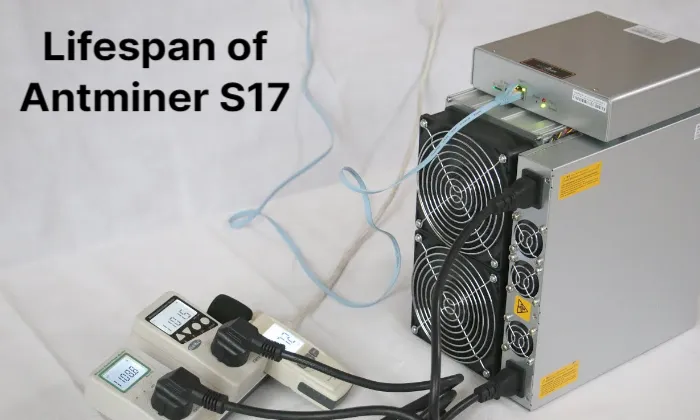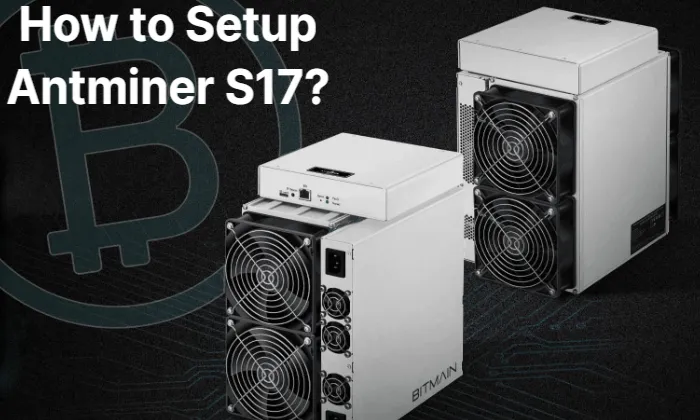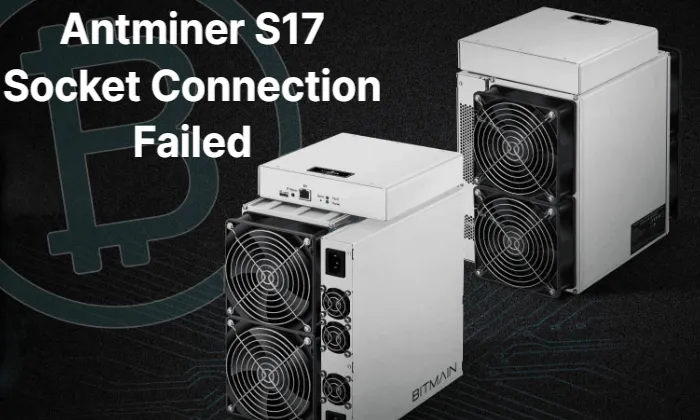This article will discuss how much bitcoin an Antminer S17 Pro (53Th) produces in addition to offering more information on bitcoin mining and Antminer S17 Pro (53Th).
The Bitmain Antminer S17 Pro (53Th) is a Bitcoin miner, which belongs to Bitmain Antminer S17 Series. It mines the SHA-256 algorithm, with a maximum hashrate of 53 Th/s and a power consumption of 2094 W.
Out of all the coins it can mine, Bitcoin is the most lucrative. Now let’s look at the amount of bitcoin that a Bitmain Antminer S17 Pro (53Th) produces.
Table of Contents
What is Bitcoin Mining?
Bitcoin mining refers to ensuring that transactions are valid and added to the Bitcoin blockchain correctly using a global network of computers running the Bitcoin code. The process of mining is also the means by which new Bitcoins are created.
- The process of bitcoin mining involves the verification of new transactions against the Bitcoin network, which results in the production of new bitcoins.
- Bitcoin mining is the process by which Bitcoin transactions are validated digitally on the Bitcoin network and added to the blockchain ledger.
- It is done by solving complex cryptographic hash puzzles to verify blocks of transactions that are updated on the decentralized blockchain ledger.
Solving these puzzles requires powerful computing power and sophisticated equipment like Antminer S17 ASIC. In return, miners are rewarded with Bitcoin, which is then released into circulation hence the name Bitcoin mining.
How Much Bitcoin Does a Bitmain Antminer S17 Pro (53Th) Make?
Bitmain’s attempt to offer large mines a selection of potent machinery at a reasonable price is demonstrated by the Antminer S17 PRO 53 variant. The equipment’s owner saw a gain in the equipment’s cost despite a minor drop in performance.
The S17 PRO 53 is otherwise comparable to the other models in this series in terms of the ASIC-miner’s chip type, linear dimensions, and ability to be installed both horizontally and vertically. The versatility of “stuffing” simplifies the repair and operation of this equipment.
Antminer S17 PRO 53Th gives the following characteristics:
- Hashing algorithm: SHA-256
- Computation speed (hash rate): 53 TH/s
- Power Consumption: 2094 W
- Energy efficiency: 40 J/TH
- Overall dimensions: 178 x 296 x 298
- Weight of equipment: 9.5 kg
- Noise level: 82 dB
How Much Can You Make by Bitcoin Mining?
Bitcoin mining is difficult, as we have established, but hey, you can dream. You can better comprehend what you would get if you were to get a block reward by using this Bitcoin mining example.
It is significant to note that the Bitcoin mining rewards are roughly constant every ten minutes. Your payout, should you be so fortunate, will depend on whether you mine a block by yourself (unlikely) or share it with other miners in a pool.
Bitcoin pays out a mining reward each time a new “block” is entered into the permanent record of transactions. The reward is currently 6.25 BTC, which, in December 2022, when the price of bitcoin was under $17,000, was equivalent to about $105,000. The reward decreases every few years, but it is currently at this level.
In addition to that reward, transaction fees that are automatically applied when a cryptocurrency is transferred between crypto wallets provide additional income for Bitcoin miners. In contrast to block rewards, transaction fees are not constant. They change in response to network variables like the number of transactions being processed at a given moment.
As more blocks are added to the Bitcoin blockchain, the reward’s size will change. This is known as a “Bitcoin halving,” and the next one is expected to happen sometime in 2024, at which point the reward will drop to 3.125 BTC, or about $53,000 as of this writing.
When there are 21 million Bitcoins in existence, block rewards will stop, and miners will only be compensated in transaction fees from that point forward. It’s likely that you won’t be present to see the end of block rewards, which is predicted to take place around 2140.
Why Does Bitcoin Need Mining?
If you only buy or trade bitcoin, you might not have given mining much thought. It is advantageous for anyone working with Bitcoin to have a basic understanding of its technological underpinnings, though, as Bitcoin is maintained by its users.
Due to the decentralized nature of Bitcoin and other blockchain technologies, no single entity is in charge of running the network or keeping track of user balances in a centralized ledger. Instead, users themselves are in possession of Bitcoin’s historical transaction ledger. Mining is the process by which users assess whether the shared records are accurate.
Every 10 minutes or so, the network generates enough transactions to make a new “block,” which is basically a package of transactions that is encoded in a way that makes it tamper-resistant. The miner who successfully inserts a new block into the record is rewarded.
The process of mining, however, entails more than just looking for new transactions to submit. If it were possible, everyone would be able to do it. In order to prevent fraud, bitcoin mining requires an expensive process of solving difficult computational puzzles.
In an effort to be the first to calculate a value that falls within a given mathematical range, miners use computers that run cryptographic formulas trillions of times per second. After successfully completing this task, the ability to submit a block is unlocked, and the miner is rewarded if the other computers on the network verify that the block matches their records.
It is suggested that mining changes the economic incentives in favor of miners acting honorably. After spending the time and money to mine a block, you might not want to take the chance of losing your potential payout by, for example, entering false information about the Bitcoin in your account.

Can Anyone Mine Bitcoin?
Anyone can participate in the Bitcoin mining process, but unless you have access to powerful computers known as ASICs (that’s “application-specific integrated circuits”), your chances of winning a The rewards for bitcoin are not very high.
A personal computer was not necessary to mine Bitcoin when it first began, more than ten years ago. But as Bitcoin’s value has grown, so too has competition for the rewards, sparking a race to develop ever-more-powerful, faster mining technology.
Today’s most profitable miners are those who have ASIC warehouses because the mining industry has grown to be worth billions of dollars.
To help small-scale miners compete, some organizations, known as mining pools, have emerged. Under these agreements, users can pool their computing power and divide the profits they make, less a fee.
Even if you join a pool, you probably won’t get much without an ASIC. The majority of the gap in the mining industry is between those who have many ASICs and those who only have a few. Given the level of competition, personal computers are generally no longer sufficient.
However, by contributing the resources you have, you can help the Bitcoin network. Theoretically, as computing power increases, the network becomes more resilient, so any amount helps. Using free software offered by the company that supports and promotes Bitcoin, you can contribute to the network using a home computer.
What About Electricity Costs?
Unless you have access to a cheap source of electricity, it’s possible that your mining expenses will exceed your rewards. For the typical American, the following Bitcoin mining example might be useful. household.
Before starting, you should conduct research because ASICs range in cost, efficacy, and performance. But as an example, on January, a well-known ASIC called the AntMiner S17 Pro (53Th) was released. 28, 2023, was retailing for between $4799 and $24999.
The AntMiner S17 Pro (53Th) could generate about $137.93 in Bitcoin per month, according to calculations made by the mining service NiceHash using prices from January. It would cost approximately $90.42 to operate it at standard residential rates. You can still earn $47.51 at an electricity cost of $0.06 per kwH.
But that doesn’t necessarily mean mining is a losing business. If electricity prices drop or the price of Bitcoin rises, these calculations may need to be adjusted. If you believe that Bitcoin will appreciate in value over time, you might view your monthly losses as a long-term investment.
Is Bitcoin Mining With Bitmain AntminerS17 Pro (53Th) Legal?
Generally speaking, it is acceptable to mine bitcoins in the US., but some other countries have outlawed it — China is a prime illustration.
even though you are in the U.S., it’s worthwhile to check in on your local regulations, especially if you’re planning to use multiple ASICs or utilize them away from your house.
What Other Cryptocurrencies Can You Mine With Bitmain Antminer S17 Pro (53Th)?
The Bitmain Antminer S17 Pro (53Th) is a Bitcoin miner. It mines the SHA-256 algorithm, with a maximum hashrate of 53 Th/s and a power consumption of 2094 W. You can mine the coins based on SHA-256 algorithm, such as Bitcoin, Bitcoin Cash, Peercoin or Terracoin, among which Bitcoin is the cryptocurrency with the highest profit margin
Conclusion: Bitmain Antminer S17 Pro (53Th) is An Efficient Bitcoin Miner
factors, including the current Bitcoin price, the mining difficulty, and the cost of electricity.
So, if you want to mine at home and learn the fundamentals without spending a fortune, Bitmain’s Antminer S17 Pro (53Th) is probably your best bet.
FAQs
How Much Does Antminer S17 Pro Make Per Day?
Is Antminer S17 Profitable?
The Antminer S17 is a profitable piece of hardware (at current conditions) that still yields a positive ROI for bitcoin mining. But if you can’t find an S17 for a reasonable price, it gets simpler to find less expensive Bitmain alternatives as more and more businesses enter the mining hardware market.
How Long Does It Take Antminer S17 to Mine 1 Bitcoin?
The combined output of 2,334 Antminer S17e mining units, as we already mentioned, is approximately 149.2PH/s. On average this mining operation would discover a block yielding a 6.26 BTC reward every 6.25 days, which averages out to 1 BTC/day.
What is the Fastest Way to Earn Bitcoin?
- play at the Lucky Block Casino’s bitcoin games.
- mine bitcoins.
- Join the Bitcoin trading community.
- Be a part of Bitcoin lending platforms.
- Take part in Bitcoin staking.
- Join cryptocurrency airdrops.
- Participate in Bitcoin bounty programs.
- Play at cryptocurrency faucets.



